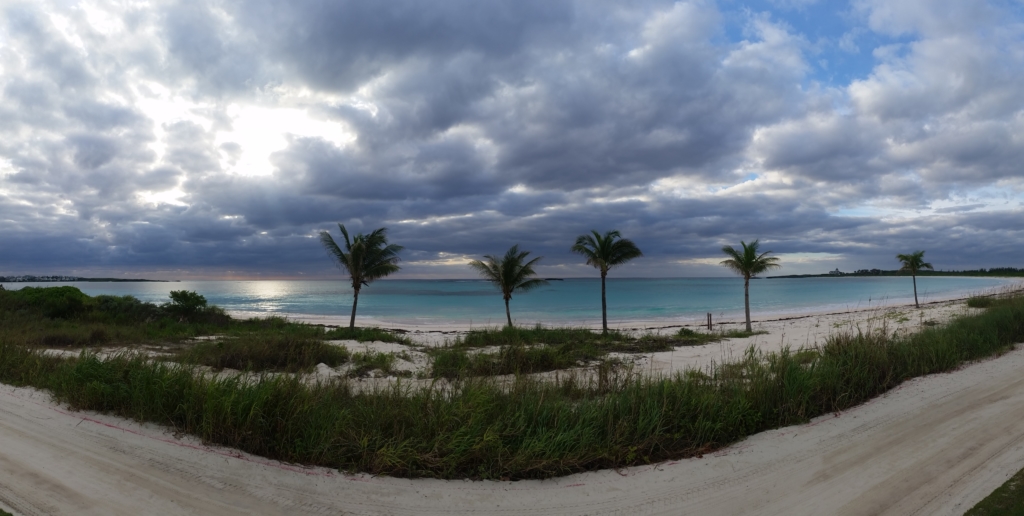These updates have been pretty upbeat recently, and justifiably so. The favourable weather throughout November and December allowed us to complete a good number of our planned construction projects before most of the greenkeeping team took a well deserved festive break. Unfortunately, things have taken a turn for the worse since New Year. High winds, torrential rain, and regular batches of snow and hail have hampered our progress and “forced” us inside. After two weeks which were predominantly spent painting the inside of the golf house, servicing machinery, and making new tee markers, the opportunity suddenly arose for me to leave all this “misery” behind and jet off to our sister club in The Bahamas, The Abaco Club, to help the greenkeeping team there to prepare for the Web.com Tour event they were hosting. Now, I know this blog is supposed to be all about Machrihanish Dunes, but I am also aware of just how depressed you will all be with the grim conditions that have engulfed Scotland’s golf courses of late. I figured that recounting the story of my trip might make for an interesting read, and that the accompanying pictures might, at the very least, cheer everybody up a bit!

The Island and the Resort
I had never been to the Caribbean before, and although I had obviously heard of The Bahamas, I hadn’t ever studied a map of them. I had never realised that there was such a collection of small islands governed from one central point, and I found the similarities between The Bahamas and the islands off the west coast of Scotland to be very interesting. Great Abaco (the island where the resort is situated) is west of Freeport and north of Nassau, and the population is around 17,000. The main port town of Marsh Harbour is served by a small airport and about 6,000 people live there. Even just digesting these initial numbers suggests that the same issues that account for both the unspoilt charm and the logistical issues that characterise our own islands should also be indicative here and this is absolutely the case. The cost of living is high, the links to the wider world are expensive and can, in some cases, be unreliable, and there is limited availability to some of the “luxuries” that people living in large conurbations might regard as essential. But the sense of community, the quality of the local cuisine, and the culture that define the island have been retained in a way that might be impossible if further development were financially viable or even possible. Having lived on a Scottish island with a proud heritage for many years, I am aware that life there will thankfully never change, and I think the same will most probably turn out to be the case for a lot of these idyllic Caribbean islands.
The Abaco Club on Winding Bay is situated right in the middle of this island paradise. The magnificent Steel/MacKenzie-designed golf course hugs the coastline, surrounding the development on all sides. The houses and restaurants that are perched on the cliff face afford mind-blowing views out into the Atlantic that would stretch all the way to Lanzarote if only the earth were flat. Some of the houses are privately owned but there is a range of accommodation available to rent for holiday purposes, and these are served by a selection of on-site restaurants and friendly bars that offer up sensational food and relaxed conversation on a daily basis. There is no hint of snobbery here and I had a great time chatting with people from all kinds of backgrounds and walks of life.
The Tournament
The schedule for the Web.com Tour looks exhausting. There are 27 events in all, starting with two stops in the Bahamas in January before heading to Panama, Colombia, and Mexico, and finally landing in mainland USA in March for a drive around the country that eventually leads to a tour championship in Florida at the end of September. The Bahamas Great Abaco Classic is the second tournament of the year, and the set-up for this is scrutinised every bit as carefully as it is for the elite events on the main PGA Tour. An agronomist is based on-site in the weeks before the players arrive, and his job is to ensure that the course is maintained to a suitable standard to enable the tournament to run smoothly and provide a fair and exacting test of golf.

Needless to say, Abaco passed this examination with flying colours. The surfaces of the paspalum greens were flawless and the grass was in excellent health, so it was relatively easy for Superintendent Matt DiMase to manipulate them to provide the tour with exactly the green speed that they were looking for. Fertilisation had been carefully monitored to ensure that clipping yields from regular mowings were extremely low during the week of the tournament, and the surfaces were very firm with little sign of excessive organic matter. No topdressing was done during my time at the Club, but clearly, a good regime is in place here that ensures the sandy profile of the upper rootzone is kept in prime condition. Working with paspalum was interesting and I could relate to Matt’s battle to create a monoculture of this species through the greens, tees, approaches, and fairways as it mirrors our own work at Machrihanish Dunes as we attempt to favour perennial bents and fescues over invasive annual meadowgrass. The bermudagrass which tries to infiltrate the paspalum surfaces struggles due to relatively poor salt tolerance.On the shoreside holes, it was clear to see that the paspalum was winning the battle. It provides a brilliant putting surface when it is maintained as well as it was here. Even I could hole out with monotonous regularity. It’s actually a shame that it is far too cold and far too dull on the west coast of Scotland to try and grow this grass here, as its other characteristics would ensure it would compete well on our shoreside holes. But I think our weather would be as welcome to this grass as it would be towards the Bahamian greenkeepers who look after it!

There was a squad of around 20 local guys working on the course under the supervision of Matt and his assistants, Juan Carlos and Sherwood, and they were keen and hilarious. Working with them was like watching the film Cool Runnings with five times the size of cast. There are some real characters there. They know how to put a shift in, though, and they would always turn up before the 5am start time, ready to go almost instantly. Collectively, they had a real interest in the golf course and greenkeeping and they welcomed me onto their team immediately, bombarding me with questions about grass, what our course was like in Scotland, and how our lives compared with the relatively sheltered existences they were living out on their own wee patch of paradise. They drooled over pictures on my phone of Machrihanish Dunes, but they were absolutely horrified by some of my images of our weather!
In the days leading up to the tournament, I was put in charge of collecting performance data for the tour agronomist, which would get logged on a spreadsheet and saved for posterity in order to assess what improvements were being made to turf conditions. The Bahamas government signed a 3-year deal to host this event, so the data will provide Matt and the tour with useful information in the run up to future tournaments. Although it might sound like collecting data was an unimportant task in comparison to changing holes or cutting greens, I was pleased to be able to take the responsibility away from Matt, as he knew he could trust me to log the information responsibly. As it was, he still ended up running about in all directions trying to direct his team while being pulled all over the place by the various officials that inevitably needed his input. Collecting the data twice daily gave me the opportunity to see at first hand how the paspalum greens reacted to the subtle changes that were made to the maintenance program, and it was interesting to see how similar these greens performed to our own. Missing a roll made them run a few inches slower, whereas rolling twice a day had a marked effect on speed and firmness. By the Friday before the tournament started, (this Web.com Tour event ran from Sunday-Wednesday) they were brick hard and rolling at least 6 inches faster than the tour had requested. The weather had been relatively cool (I had my shorts on, but most of the local lads were shivering in jackets) and moisture levels were around 12-15 percent, so the standard cutting and rolling regime had been enough to turn the greens into scary monsters overnight. I have often scoffed when watching greenkeepers mess about with stimpmeters and firmness testing equipment, but in a situation like this, the data that these instruments provide really do help in the decision-making process. A quick adjustment to the program saw the performance of the greens calm down sufficiently that they were perfect going into day 1 of the tournament, and stayed that way until well after the pampered pros had finished with them. They enjoyed putting on them every bit as much as I did.

Daily course preparation went like clockwork, despite the greenkeeping team being forced to deal with a two-tee start and a delay at the end of day 1 that meant some players had to come back out and finish their rounds the next morning. We could not even begin to see where we were going until 6.20am, so with golfers due to tee off on 1, 8, 9, 10, 16, 17 and 18 at 6.50am, that second morning turned out to be a major logistical headache. If you have enough machines and manpower and you are well enough organised, you can achieve pretty much anything, though, and these boys were pretty good at mowing with their lights on.
The tournament turned out to be highly competitive and was extremely good entertainment. I’m sure some people would have liked the winning score to have been a little lower than -17, but with at least half a dozen players in the mix right up to the last hole, it made for compelling viewing. The 18th at Abaco has a relatively wide fairway but it is flanked on both sides by coral shelves and absolute jungle. It would be a frightening prospect if you were protecting a lead, so even though the scoring was good, there is no doubt that the course provided a worthy winner in Adam Svensson. The prizegiving was an extravaganza, with all sorts of local officials and dignitaries present. This showed just what an event of this stature means to a place like Great Abaco and The Bahamas as a whole in terms of exposure and marketing potential. I am sure the government will be keen for the event to showcase the undoubted beauty of their islands for many years to come!

Back Home
I loved my trip to The Bahamas. The local people were exceptionally welcoming, the food was incredible, and some of the places we visited outside of the resort were stunningly beautiful (Sandy Point was an obvious highlight). I would definitely recommend Great Abaco as a destination for anybody who is looking for somewhere relaxing and surprisingly unspoiled to go on holiday. I don’t think I could live there, though, any more than I could go back to living on a Scottish island. I have it too good here in Campbeltown, and it only took a fleeting appearance of the winter sun this week to remind me that there aren’t many finer golf courses to work on than Machrihanish Dunes. It is worth putting up with the bad days on the west coast of Scotland in order to truly revel in the good ones!

